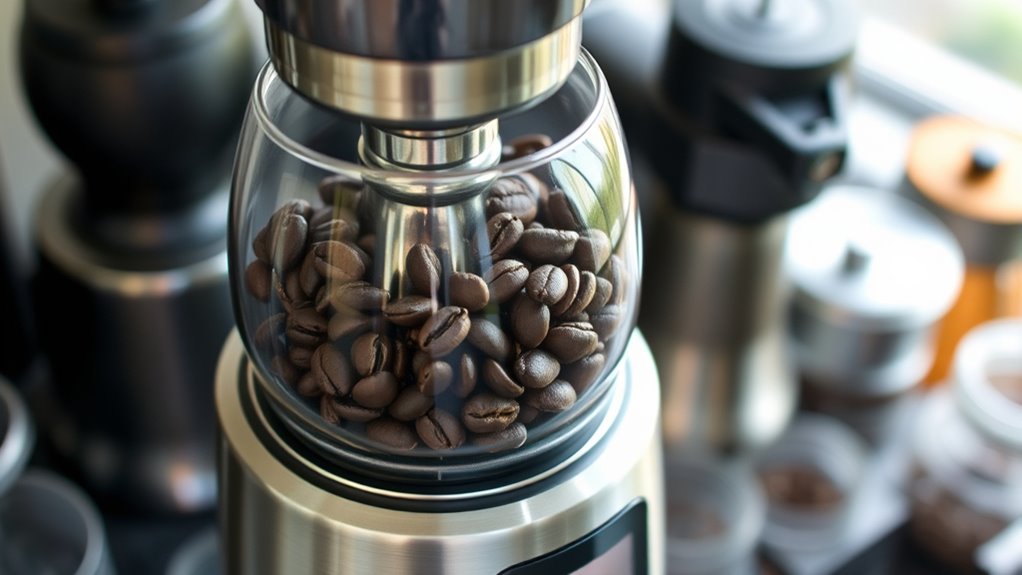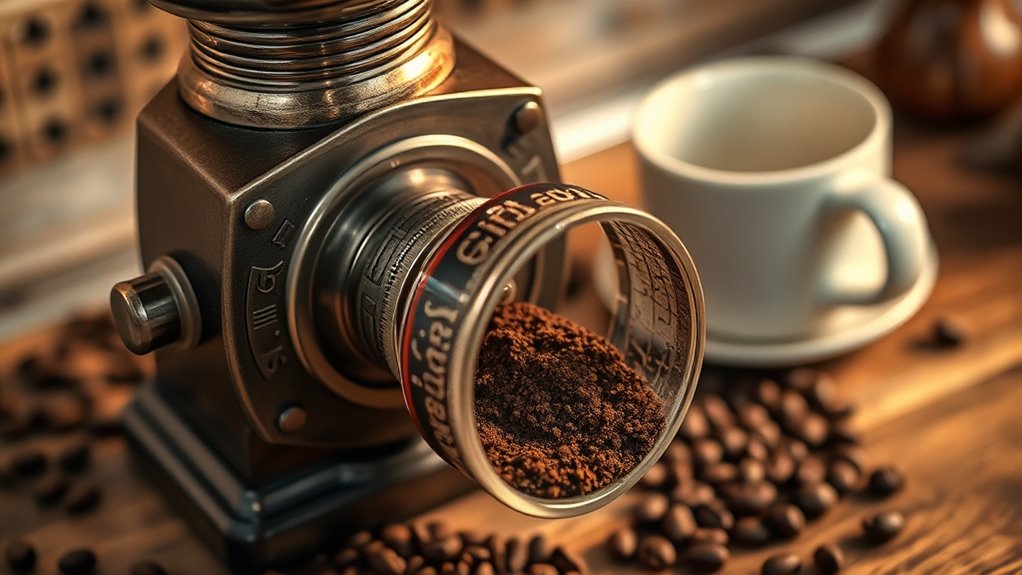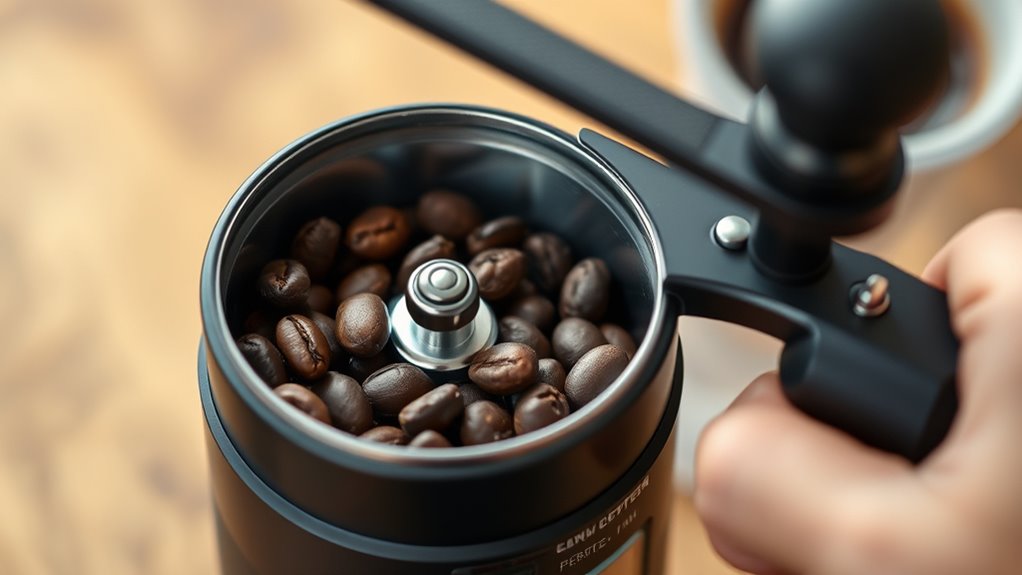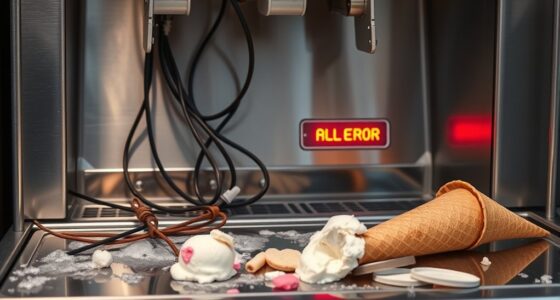In most cases, spending more on a coffee grinder gives you better consistency, control, and flavor. Expensive models often feature high-quality burrs, precise grind settings, and quieter operation, which are especially important if you brew often or enjoy multiple methods like espresso or pour-over. However, if you only brew occasionally or are on a tight budget, a basic grinder can suffice—yet, upgrading can truly enhance your coffee experience if you keep exploring.
Key Takeaways
- Higher-end grinders offer more consistent, uniform grounds, improving flavor extraction and overall coffee quality.
- Budget grinders may produce uneven grounds, leading to inconsistent extraction and compromised taste.
- Burr grinders, especially premium models, provide better control over grind size than cheaper blade grinders.
- The decision to invest depends on your brewing style, frequency, and how much inconsistent grounds affect your experience.
- Maintenance, durability, and noise levels are also important factors when choosing between affordable and expensive grinders.
Understanding the Price Range of Coffee Grinders

Understanding the price range of coffee grinders is essential to finding the right balance between performance and budget. You can find quality home-use grinders starting around $100 to $200, offering a good mix of affordability and reliable results. Cheaper options, like basic blade grinders under $40, tend to produce uneven grounds and aren’t very durable, but they’re suitable for beginners or occasional use. On the higher end, premium grinders with advanced features, better burr materials, and precise grind control can cost $300 or more, delivering superior consistency and flavor extraction. Investing more often means quieter operation, longer-lasting parts, and improved grind uniformity, which directly impacts your coffee’s taste. Additionally, understanding the price range of coffee grinders can help you make an informed decision aligned with your brewing preferences. Being aware of the performance features associated with different price points can further assist in selecting a grinder that meets your specific needs, especially since the quality of burrs significantly influences grind consistency and flavor.
Differences Between Burr and Blade Grinders

Burr and blade grinders differ markedly in how they process coffee beans, affecting the consistency and quality of your grind. Burr grinders use two revolving abrasive surfaces to crush beans evenly, giving you precise control over grind size. Blade grinders, on the other hand, chop beans with a spinning blade, resulting in inconsistent particle sizes. Visualize a burr grinder as a steady, uniform mill, and a blade grinder as a blender with erratic chopping.
Burr grinders crush beans evenly for consistent, precise grounds; blade grinders chop chaotically, producing uneven particles.
- Imagine a smooth, uniform surface transforming beans into even particles.
- Picture a blade spinning chaotically, producing uneven grounds.
- Envision a gentle, controlled crush versus a wild chopping motion.
- Think of a fine-tuned dial for precise grind settings versus a single-speed blade.
- Understanding the part of the plant involved in each method helps optimize flavor extraction.
How Burr Material and Shape Affect Performance

The material and shape of your coffee grinder’s burrs directly influence how efficiently and effectively beans are ground. Burr material affects durability, heat, and noise, while shape impacts speed, heat, and grind consistency. Steel burrs are common, offering fast and tough performance, but may generate heat. Ceramic burrs grind cooler, quieter, and stay sharp longer, though they’re more fragile. Shape matters: conical burrs run slower, produce less heat, and are quieter, ideal for manual or versatile brewing. Flat burrs are faster, better for espresso, but noisier and produce more heat. Choosing the right combination depends on your brewing needs and budget. Here’s a quick comparison:
| Burr Material | Burr Shape |
|---|---|
| Steel | Conical |
| Ceramic | Flat |
| Steel | Flat |
| Ceramic | Conical |
| Mixed | Custom |
Additionally, burr shape influences how evenly the coffee grounds are distributed, which affects overall extraction quality. The choice of burr material can also impact the longevity of your grinder and maintenance requirements. Research on burr durability shows that selecting durable materials can reduce replacement costs over time. Selecting the appropriate burr design can optimize your brewing experience and ensure consistent results over time. For example, some burr configurations are better suited for specific brewing methods, enhancing flavor extraction and efficiency.
Selecting the Right Grinder for Your Brewing Style

Choosing the right grinder depends heavily on your preferred brewing method, as different styles require varying levels of grind precision and consistency. If you enjoy espresso, you need a grinder with fine, uniform settings to guarantee proper extraction. For pour-over or AeroPress, a medium grind with consistent particle size helps optimize flavor. French press demands a coarse grind for proper steeping, while drip coffee benefits from a medium-coarse setting for balanced extraction. Consider these visual cues:
- A finely textured, powder-like grind resembling sugar
- Uniform, pebble-sized particles for even extraction
- Coarse, chunky grounds similar to sea salt
- Medium consistency with a slightly gritty feel between thumb and forefinger
Matching your grinder to your brewing style ensures better flavor, clarity, and overall coffee experience. Additionally, selecting a grinder that offers grind consistency can significantly impact the quality of your brew.
The Impact of Grind Consistency on Coffee Flavor

Your coffee’s flavor depends heavily on grind consistency because uniform particle sizes allow for even extraction. When the grind is uneven, some grounds over-extract while others under-extract, leading to bitter or sour tastes. Focusing on particle size and its impact can help you brew more balanced and flavorful coffee every time. Additionally, understanding the optimal angles for pinball machines can inspire you to fine-tune your setup for better results. Properly calibrated tuning techniques can also improve your coffee grinder’s performance and consistency over time. Being aware of how cookie categories influence your browsing experience can help you make more informed choices when customizing your brewing setup or exploring new gear.
Uniformity and Extraction
Grind consistency plays a vital role in determining the flavor and overall quality of your coffee. When your grind is uniform, water flows evenly through the grounds, extracting the right flavors and creating a balanced cup. Inconsistent grind sizes cause uneven extraction, resulting in bitter, sour, or flat flavors. A high-quality grinder ensures particles are evenly sized, improving extraction and flavor clarity. Imagine:
- Tiny, uniform particles that allow water to saturate evenly
- Consistent flow that pulls balanced, nuanced flavors
- Removal of over-extracted bitter notes
- Better control over brewing variables, like pressure and time
- Grind uniformity is essential for achieving optimal extraction and flavor clarity. Proper calibration of your grinder can further enhance particle size distribution, leading to more consistent results. Regular maintenance and cleaning help maintain grind consistency, ensuring each brew remains flavorful and smooth. Additionally, advancements in AI-driven grinding technology promise even greater precision and consistency in the future. This uniformity means your coffee is more flavorful, smoother, and more enjoyable. Investing in a grinder that produces consistent grounds helps you unleash the full potential of your beans and elevate your brewing experience.
Particle Size and Taste
The size of coffee particles directly influences the flavor and overall quality of your brew. When your grind is uniform, extraction happens evenly, highlighting the coffee’s nuanced flavors and balanced acidity. If your grind varies too much, some particles extract quickly, resulting in bitterness, while others under-extract, causing sourness or a weak taste. Cheap blade grinders often produce inconsistent particle sizes, leading to uneven flavor profiles. On the other hand, high-quality burr grinders deliver consistent particle sizes, ensuring each sip is rich and well-rounded. Precise grind control allows you to fine-tune extraction for different brewing methods, whether espresso or French press. Additionally, particle size distribution plays a crucial role in determining the extraction efficiency, which directly impacts the flavor profile. Regional statistics can also inform expectations regarding the impact of grind consistency on flavor quality. Moreover, understanding the influence of relationships in coffee extraction highlights how critical grind consistency is for achieving the desired flavor profile. Ultimately, grind consistency plays an essential role in revealing the full potential of your coffee’s flavor profile.
Features to Consider Beyond Cost

While price often signals quality, several features beyond cost considerably influence a coffee grinder’s performance and lifespan. You should consider aspects like build materials, noise levels, ease of cleaning, and grind consistency. These factors affect your daily routine and the quality of your brew. For example, durable metal parts and high-quality burrs ensure longevity and precise grinding, while quiet motors make early mornings less disruptive. Easy-to-clean designs save time and maintain flavor integrity over years. Additionally, consistent grind size impacts flavor clarity and extraction. When evaluating grinders, pay attention to burr material and shape, as they directly determine grind precision and durability. Material quality especially influences how well the grinder withstands regular use and corrosion. Understanding grind consistency helps in choosing a grinder that produces the desired flavor profile with each brew. Keep these features in mind, and you’ll select a grinder that not only fits your budget but also elevates your coffee experience.
Manual Versus Electric Grinders: Which Is Better for You?

Choosing between manual and electric coffee grinders depends on your lifestyle, budget, and brewing preferences. If you value portability, a manual grinder like the 1Zpresso Q Air offers control, affordability, and is perfect for travel or quick setups. It’s quieter, requires no power, and lets you enjoy a hands-on experience. On the other hand, an electric grinder, such as the Fellow Opus, provides convenience and consistency, making it ideal for daily use or larger batches. Electric models save time and effort, especially with multiple cups or fine espresso grinding. Your choice hinges on how much you prioritize convenience versus control. If you enjoy the process and want a budget-friendly option, manual might be your best bet. For speed and ease, electric is the way to go.
The Role of Burr Size and Speed in Grinding Quality

Burr size and speed directly impact the consistency and efficiency of your grind, shaping the overall quality of your coffee. Larger burrs, like 64mm, cut beans faster and produce more uniform particles, which enhances extraction and flavor clarity. Smaller burrs, around 38mm, are slower but still effective for home brewing. Higher-speed grinders process beans quickly but can generate more heat, risking flavor loss. Slower, precision-adjusted grinders preserve bean integrity and reduce heat buildup.
- Imagine a giant burr slicing through beans smoothly, creating even grounds.
- Visualize a high-speed grinder humming loudly, with particles flying unpredictably.
- Picture a slow, steady burr gently grinding, maintaining bean freshness.
- Envision a compact burr spinning rapidly, producing fine, consistent espresso grounds.
Maintenance and Longevity of Coffee Grinders

To keep your coffee grinder running smoothly, regular maintenance is essential. You should clean it often and handle components carefully to prevent wear and tear. Proper upkeep not only extends its lifespan but also guarantees consistently fresh and flavorful grounds.
Durability of Components
The durability of coffee grinder components directly impacts how long your device will perform reliably and how much maintenance it will require over time. High-quality parts, like sturdy burrs and metal gears, resist wear and keep your grinder functioning smoothly. Cheaper models with plastic parts are prone to cracking and breaking, reducing lifespan. You’ll notice:
- Metal burrs that stay sharp longer and resist chipping
- Steel or ceramic components that withstand repeated use
- Heavy-duty motors designed for consistent operation
- Rigid housing materials that handle daily wear
These features ensure your grinder remains dependable, saving you money and frustration. Investing in durable components means fewer replacements, less downtime, and consistently better coffee experiences. Durability directly influences your grinder’s longevity and performance stability.
Cleaning and Maintenance Practices
Regular cleaning and maintenance are essential for keeping your coffee grinder performing at its best and extending its lifespan. You should wipe down the exterior regularly to prevent dust buildup and remove leftover coffee grounds from the chute and burrs. For burr grinders, disassemble the hopper and burrs every few weeks, brush away residual grounds, and run a cleaning cycle with grinder cleaner or rice to remove oils and buildup. Always check for jammed beans or debris and address them promptly. Lubricate moving parts if recommended by the manufacturer, and replace worn burrs as needed. Proper maintenance reduces clogs, preserves grind consistency, and prevents motor strain, ensuring your grinder stays reliable and delivers great-tasting coffee for years.
When Is Investing in a Higher-End Grinder Worth It?

Investing in a higher-end coffee grinder makes sense when you’re serious about maximizing flavor and consistency. If you value precise control over grind size, enjoy experimenting with different brewing methods, or regularly make espresso, a quality grinder is essential. It’s worth it when you notice the difference in your cup—more clarity, balanced extraction, and fewer bitter or sour notes. Think about these scenarios:
- You want uniform particles for ideal extraction
- You brew multiple methods, from espresso to pour-over
- You’re tired of inconsistent grounds from cheaper models
- You appreciate quieter operation and durable build quality
In these cases, a premium grinder’s enhanced burrs, better materials, and precise adjustments can elevate your coffee experience, making the investment well worth it.
Frequently Asked Questions
How Does Grinder Noise Affect My Morning Routine?
Grinder noise can disrupt your morning routine by waking others or creating a stressful start. If you have early or shared mornings, a loud grinder might cause frustration or inconvenience. Choosing a conical burr grinder or one with quieter motors can help maintain a peaceful environment. You’ll enjoy your coffee prep without disturbing your household, making your mornings smoother and more enjoyable.
Can a Cheap Grinder Produce Quality Espresso?
A cheap grinder can produce decent espresso, but it’s unlikely to deliver consistent, fine grounds needed for ideal extraction. Cheaper models, especially blade grinders, tend to be uneven, resulting in bitter or sour flavors. If you’re serious about espresso, investing in a burr grinder—even a mid-range one—will give you better control over grind size and consistency, leading to a richer, more balanced shot.
Is Grind Retention Noticeable in Flavor Differences?
Imagine brewing your morning pour-over with freshly ground beans, then noticing a subtle stale taste. Grind retention can cause flavor differences because stale grounds mix with fresh ones, affecting taste. For example, a high-end grinder with low retention keeps flavors pure, while cheaper models may trap old grounds, dulling your brew. You’ll notice improved clarity and brightness when your grinder minimizes residual coffee, ensuring each cup tastes fresh and vibrant.
Do Ceramic Burrs Really Last Longer Than Steel?
Yes, ceramic burrs typically last longer than steel because they’re more resistant to dulling and retain their sharpness longer. You might notice fewer burr replacements over time, especially with frequent use. However, ceramic is more fragile and can chip or break if dropped or subjected to hard objects. If you prioritize durability and quieter grinding, ceramic burrs are a solid choice, but handle them carefully to avoid damage.
What’s the Best Grinder for Travel and Portability?
You should choose a manual grinder like the 1Zpresso Q Air for travel and portability. It’s lightweight, compact, and easy to carry, making it perfect for brewing on the go. Manual grinders don’t require electricity, so you can use them anywhere. They also offer consistent grind sizes for pour-over, AeroPress, or French press, ensuring you get good coffee experience while on the move without bulky or heavy equipment.
Conclusion
So, next time you’re pondering if an expensive grinder’s worth it, remember that your brewing style, taste, and budget all play a role. Sometimes, a simple upgrade or a well-chosen manual grinder can unexpectedly elevate your coffee experience. It’s funny how a small investment can turn your daily brew into a moment of pure bliss. After all, the perfect cup often comes down to the details—and those details might just surprise you.









